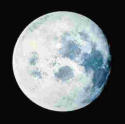

http://www.thesleepsite.com/
Angular Momentum
The face of the Moon has a
universal recognition. The reason the
Moon shows one constant face towards the Earth is because one rotation
about
its axis is equal to the time it takes for it to revolve once about the
Earth.
Both rotation and revolution are 27.3 days. The
reason the Moon has a locked rotation with
the Earth is due to tidal effects. There
is a great tidal force upon the Moon from Earth’s gravitational pull. Due to this strong
force, the
Moon has slowed its spin until it had the same period of rotation as
one
revolution around the Earth (Moons and Rings 1991, 26).
One of the observable
gravitational
effects of the Moon upon the Earth are ocean tides.
The Moon’s gravity also exerts a force on the
Earth’s surface and atmosphere but are not as easily detectible. The tidal movement of water on the ocean
floor causes friction. This friction,
which is most notable in the shallow seas such as the
One of the more commonly known laws is that change is undeniable. With the changing orbit of the Moon, it follows that it will not be in orbit forever. Eventually the Moon will extend it’s distance from the Earth until it can go no further. Then the tidal effects of the Sun will pull the Moon closer to the Earth. The Roche Limit is the boundary where tidal forces disturb the stability of a planetary body. The boundary of the Roche Limit “extends two and a half times the radius of a planet from it’s center” (Moons and Rings 1991, 27). When the Moon falls within this limit, the stress caused by the Earth’s force of gravity will break apart the Moon and it will be no more.
There is no need to worry about the demise of the Moon. The Moon is not projected to reach the Roche Limit for another 10,000 million years. The Sun however, is projected to die out in at least 5,000 million years, long before the destruction of the Moon. The planet Earth should be inhospitable for life by that time so chances are there will not be a human observation of such an event (Moore 1976, 39).